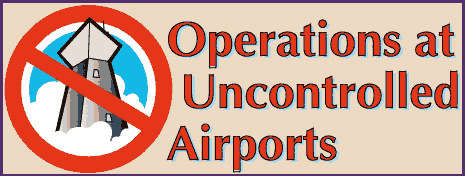
Spring cleaning around the
house requires clearing cobwebs out of hidden corners. Apparently the
same holds true for pilots who have been flightless during the winter,
or have been on vacation for a while. An instructor reports on his cobweb-clearing
efforts with a seaplane pilot:
- I was
giving a springtime seaplane checkout to a rated pilot for currency
and to blow off the cobwebs after a long winter. I picked a long stretch
of water to simulate a heavy or high density takeoff by using less
than full power for takeoff. The trainee showed a lot of cobwebs,
and could not get the seaplane airborne. A boat moving toward us caught
my eye. I looked over the nose and realized we were approaching a
shallow area followed by the shoreline with tall trees and a few houses.
I took the controls and got the seaplane off the water...barely clear
of the trees and houses.
Trainees who "show a
lot of cobwebs" bear extra monitoring, particularly when practicing
advanced or difficult maneuvers.
Even highly-qualified pilots
are prone to cobwebs if they lack recent flight experience, as an air
carrier First Officer learned on a flight with a company Flight Manager.
- I was
flying with a Flight Manager, that being the equivalent of an Assistant
Chief Pilot. He had only flown 28 hours in the last 6 months. We were
climbing to an assigned altitude of 12,000 feet. Through 11,000 feet,
I called 1,000 feet to go, and the altitude alerter worked normally.
At 11,600 feet, we were still climbing at 3,000 feet per minute, so
I mentioned that we were approaching our altitude. At 12,100 feet,
I said, "There's our altitude." The Captain immediately
pushed the aircraft over. We returned to 12,000 feet.
I made the erroneous assumption
that, despite the lack of current flight time, his proficiency would
be good due to his position, and that this lack of time would not affect
a Flight Manager as much as a line pilot. Also, I was reluctant to speak
up as much as I should have, [due] to the position held by this individual...and
my respect for him.
The reporter suggests that the Flight Manager's status may have inhibited
the reporter's typical use of CRM skills, thereby inadvertently contributing
to this minor altitude deviation.
Plan
to Close that Flight Plan
Some pilots who have been
out of the flying game for awhile may have lost the habit of closing
a flight plan. Two reporters offer stories of unusual circumstances
surrounding flight plans left open. First, a general aviation pilot
relied on the Tower to close a VFR flight plan, as would be typical
for this airport--except when the Tower is closed.
- I was
flying a club aircraft out of [a military base] and opened a local
VFR flight plan with FSS. The base Tower normally closes flight plans
when the aircraft arrives, but the Tower was closed. When Tower is
closed, I normally close with FSS via radio while still airborne,
but low visibility distracted my attention. First time in over 35
years of flying that I forgot to close my flight plan!
The good news: the aircraft was airborne again [with the next renter-pilot]
before the FAA would have begun a search. The new pilot was opening
his flight plan with FSS before FSS would be calling to look for an
overdue aircraft.
Several years ago, CALLBACK
published letters from a number of readers who offered memory-joggers
for closing flight plans. Suggestions included wearing your watch on
the wrong wrist, rolling up one pant leg, leaving notes in your car,
attaching a clothes pin to the aircraft ignition key or even your shirt
collar, and, of course, adding a line item to the aircraft landing or
shutdown checklist.
A flight crew on an IFR flight
plan normally can rely on the mere completion of their flight into a
Tower-controlled airport to effectively cancel their IFR plan. In our
next report, from an air carrier Captain, a bit of a twist was at the
heart of the failure to cancel an IFR flight plan:
- Just outside
the outer marker, Center gave us a hand-off to Tower. We checked in
with Tower... and were advised that the Tower would probably close
[for the evening] before we arrived. We reported the outer marker
to the Tower and they said that they were closing the Tower.
After landing, we were given a report over Tower frequency that braking
action was poor on the taxiways. We taxied in and parked, never going
back to Center to cancel IFR. Another air carrier's ground personnel
canceled for us with Center. Having received the braking action report
after touchdown, neither of us thought about canceling the flight
plan. Our mindset was "situation normal" for a Tower airport.
The situation became non-normal
the moment the Tower reported closing. That announcement should have
given the crew a "heads-up" that they were now responsible
for canceling their IFR flight plan.

Non-standard procedures at
uncontrolled airports continue to be a frequent subject of ASRS reports.
In our first report, a general aviation pilot preparing for a landing
met transient traffic in an unexpected place at an uncontrolled airport.
- About
5 miles out, I called for an airport advisory, then a couple of minutes
later, I called to announce that we were 2 miles south of the airport.
The airport wasn't very busy, with just one plane taking off. I looked
for traffic along the downwind leg that might interfere with our entrance
into the pattern and that might not have a radio or had failed to
make use of the one they did have. Everything looked clear. I announced
that we were mid-field at 1,400 feet entering a downwind for Runway
28. Just after crossing over the runway, I looked down to check the
windsock...and saw the shadow of another airplane converging on our
shadow with only seconds to go. I turned my head just in time to watch
the wing of a high-wing aircraft slide under the tail of our plane
no more than 20 feet below us. It was a chilling sight.
It was an enroute aircraft, not landing at our airport. Good pilots
use the radio and fly above the traffic pattern when traversing an
airport's traffic area. Other pilots may not.
The reporter concludes that
the basic "see-and-avoid" rule is still the best defense against
pilots who are not following good operating procedures.
An airport that normally
has an operating Control Tower becomes an uncontrolled airport when
the Tower closes for the night. Pilots then use the Tower frequency
as a Common Traffic Advisory Frequency (CTAF). At least some pilots
do. An air carrier Captain reports:
- We transmitted
our intentions on CTAF and proceeded to Runway 20. During taxi, we
heard no other radio calls. We announced on CTAF that we were taxiing
onto Runway 20. We had still heard no calls from any other aircraft.
I was about to advance the throttles, when to our total astonishment,
we saw a light aircraft lifting off, coming straight at us on Runway
2. Due to the lay of the land, we were unable to see him until he
lifted off. He flew overhead and finally broke the silence by announcing
that he was turning downwind. After he was well clear, we departed
uneventfully. It was just luck and fortunate timing that we did not
meet head-on at high speed at mid-field.
The preceding reports emphasize
the importance of vigilance and radio communications at uncontrolled
fields.
A
Roast, But No Picnic
FAR 91.103 requires pilots
to familiarize themselves with all available information about their
flights. Our next reporter used several means to familiarize himself,
but neglected a basic one--a current sectional chart.
- Before
my flight, I checked NOTAMs which indicated a change of identifier,
but no frequency change. I took the frequency from a sectional which
was expired. I had a new sectional chart with me, but failed to check
the frequency. I also checked the airport guide, but it was apparently
not up to date. So basically I arrived in Class D airspace with an
outdated frequency.
I got no response from Tower, which I did not consider strange, because
on my last visit on a weekend evening, the Tower was not occupied.
There was no traffic in the air and I proceeded as if in uncontrolled
airspace...reporting my position in the pattern, however on the wrong
frequency. After I parked, I was summoned to the Tower, where the
Controller roasted me.
Pilots need to review up-to-date
publications to confirm frequencies, traffic patterns, and other relevant
airport information.
VIP*Airspace
(*Very
Important Prohibited)
Lately, ASRS has received
a number of reports concerning a very small patch of airspace that carries
very big clout--Prohibited Area P-56, over the White House in Washington,
DC. Some arrival and departure procedures for nearby Washington National
Airport (DCA) may bring pilots very close to P-56 if they do not follow
the routings precisely. A corporate First Officer reports just such
an experience:
- The clearance
was "Depart North, noise abatement procedure," not "Northwest"
as usual. The weather was VMC. I elected to fly the Potomac River
visually as was allowed by the procedure instead of intercepting the
DCA VOR 328 radial outbound. ATC then directed a turn to 270 degrees.
Later, we were informed by ATC that there may have been an incursion
into [prohibited] airspace by our aircraft.
A call was received by our employer from the United States Secret
Service, advising that they believed our aircraft to have violated
[prohibited area] P-56, north of DCA. The Captain and I were interviewed
by the Secret Service.
Upon further reflection and review of the DCA ATIS at the time, a
strong wind from the west may have been a contributing factor.



